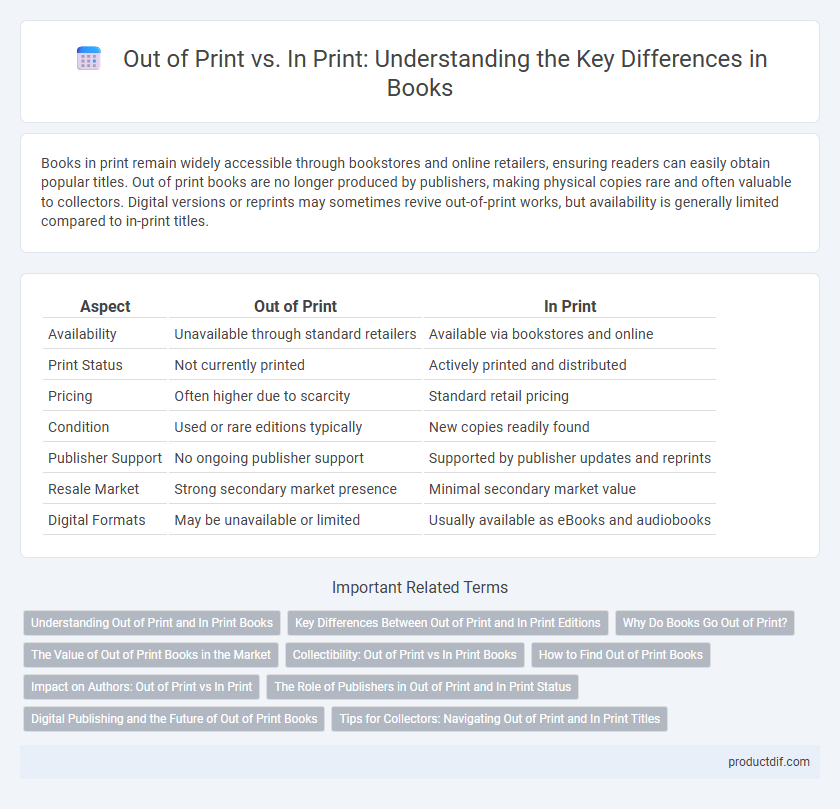Books in print remain widely accessible through bookstores and online retailers, ensuring readers can easily obtain popular titles. Out of print books are no longer produced by publishers, making physical copies rare and often valuable to collectors. Digital versions or reprints may sometimes revive out-of-print works, but availability is generally limited compared to in-print titles.
Table of Comparison
| Aspect | Out of Print | In Print |
|---|---|---|
| Availability | Unavailable through standard retailers | Available via bookstores and online |
| Print Status | Not currently printed | Actively printed and distributed |
| Pricing | Often higher due to scarcity | Standard retail pricing |
| Condition | Used or rare editions typically | New copies readily found |
| Publisher Support | No ongoing publisher support | Supported by publisher updates and reprints |
| Resale Market | Strong secondary market presence | Minimal secondary market value |
| Digital Formats | May be unavailable or limited | Usually available as eBooks and audiobooks |
Understanding Out of Print and In Print Books
Out of print books are titles no longer produced or distributed by publishers, making them rare and often harder to find in traditional retail channels. In print books remain actively published and available for purchase through bookstores, online retailers, and libraries. Understanding the distinction is crucial for collectors, readers, and authors seeking availability or resale potential within the book market.
Key Differences Between Out of Print and In Print Editions
Out of Print (OOP) editions refer to books no longer being produced or distributed by publishers, often leading to limited availability and higher collector value. In Print editions remain actively published and widely accessible through various retail and digital channels, ensuring continuous readership and market presence. The key differences hinge on availability, pricing, and distribution, with In Print books easier to source and Out of Print books often sought after by collectors for rarity.
Why Do Books Go Out of Print?
Books go out of print primarily due to declining demand, making continued production financially unviable for publishers. Rights expiration or contractual limitations can also lead to a book being withdrawn from circulation. Changes in market trends and publisher priorities contribute to the decision to let a title lapse out of print.
The Value of Out of Print Books in the Market
Out of print books often hold significant value in the market due to their rarity and limited availability, attracting collectors and enthusiasts seeking unique editions or hard-to-find titles. These books can appreciate over time, especially if associated with famous authors, first editions, or contain unique content not found in later printings. Market demand for out of print books is driven by scarcity, historical significance, and the nostalgia factor, making them prized assets among bibliophiles and investors alike.
Collectibility: Out of Print vs In Print Books
Out of print books often hold higher collectibility due to their limited availability and rarity, making them highly sought after by collectors and enthusiasts. In print books, while more accessible and easier to obtain, generally lack the same level of exclusivity and potential for value appreciation. Factors such as edition size, condition, and demand significantly influence the collectible status of out of print versus in print books.
How to Find Out of Print Books
Finding out of print books requires specialized approaches such as browsing rare book shops, using online marketplaces like AbeBooks or eBay, and exploring library archives or interlibrary loan services. Collectors and enthusiasts often rely on book scouting websites and social media groups dedicated to rare and collectible titles. Utilizing ISBNs or detailed bibliographic information enhances search accuracy for elusive out-of-print editions.
Impact on Authors: Out of Print vs In Print
Books categorized as in print continue to generate royalties for authors, sustaining their income and visibility in the literary market. Out of print status limits access, diminishing sales opportunities and potentially reducing an author's long-term earning potential. Maintaining a book in print helps preserve an author's relevance and supports ongoing reader engagement.
The Role of Publishers in Out of Print and In Print Status
Publishers play a critical role in determining a book's in print or out of print status by managing print runs, distribution channels, and rights availability. Decisions regarding reprints, digital formats, and print-on-demand technologies directly influence a book's accessibility to readers and its market presence. Strategic rights management also enables publishers to revive out of print titles or maintain continuous availability through updated editions and partnerships.
Digital Publishing and the Future of Out of Print Books
Digital publishing revolutionizes access to out of print books by converting rare and unavailable titles into easily distributable eBooks and print-on-demand copies. Advances in digital formats and distribution platforms enable publishers to reintroduce classic and niche works, extending their lifespan and market reach beyond physical inventory limitations. This shift fosters a sustainable future for out of print books, where digital availability preserves literary heritage while meeting contemporary reader demands.
Tips for Collectors: Navigating Out of Print and In Print Titles
Collectors should prioritize researching publication dates and edition numbers to distinguish between out of print and in print titles, as rarity and condition significantly impact value. Utilizing specialized databases and joining collector forums can provide timely updates on availability and market trends for sought-after books. Networking with booksellers and leveraging digital tools helps in locating rare out of print editions while securing in print titles at competitive prices.
Out of Print vs In Print Infographic

 productdif.com
productdif.com